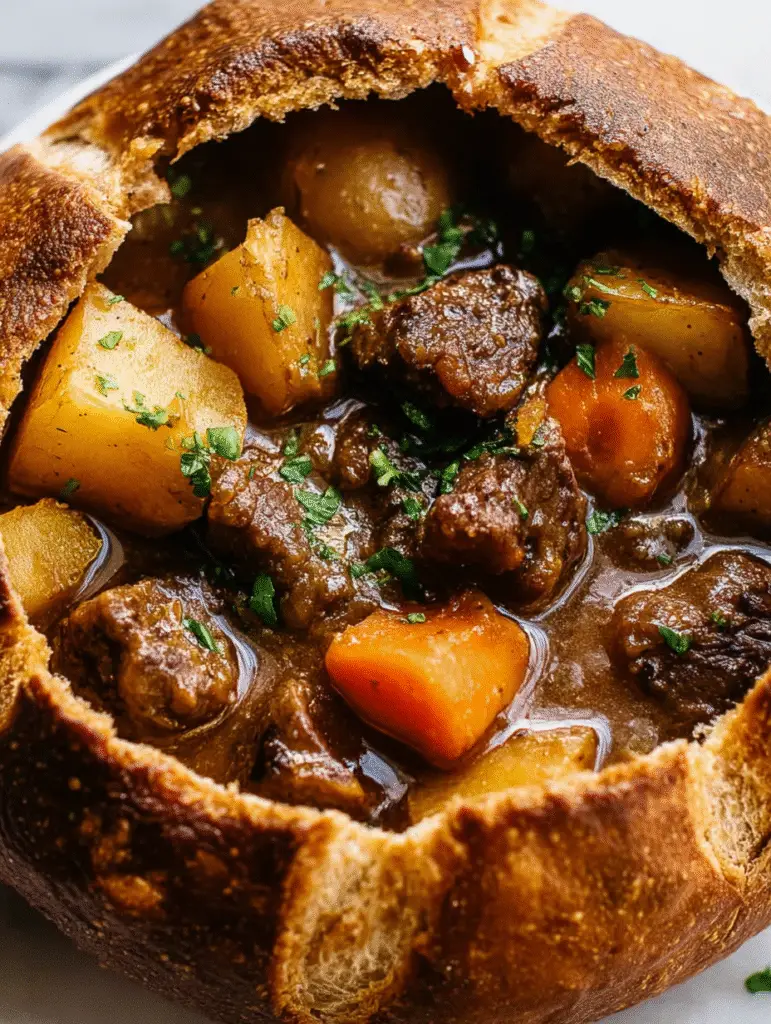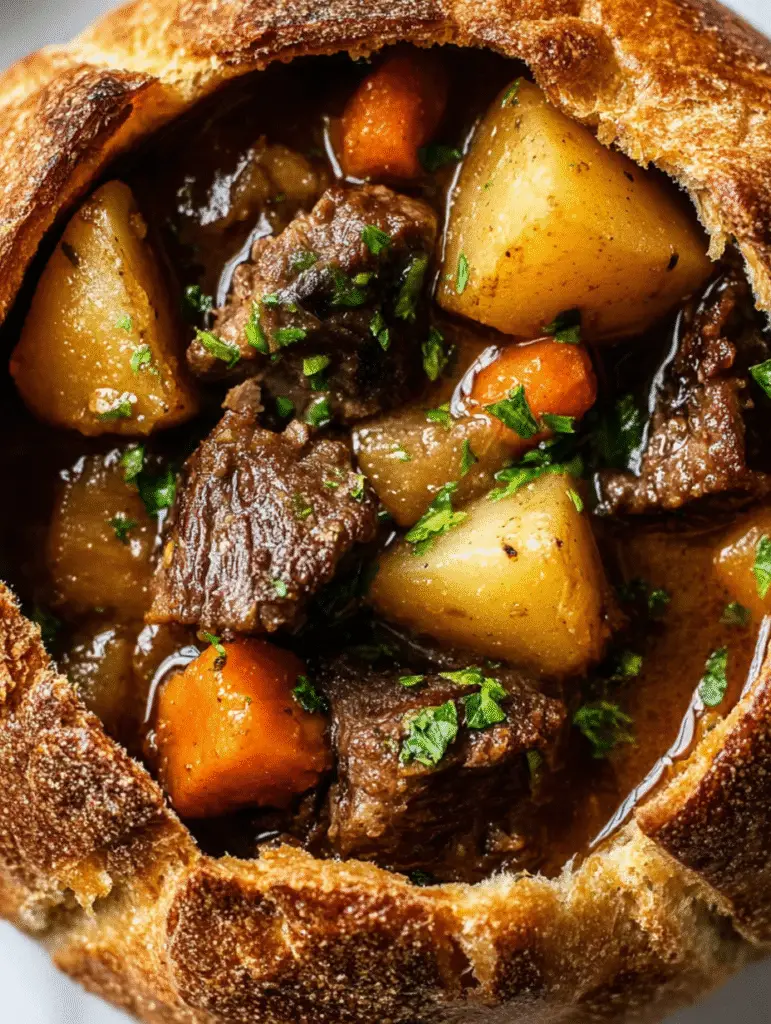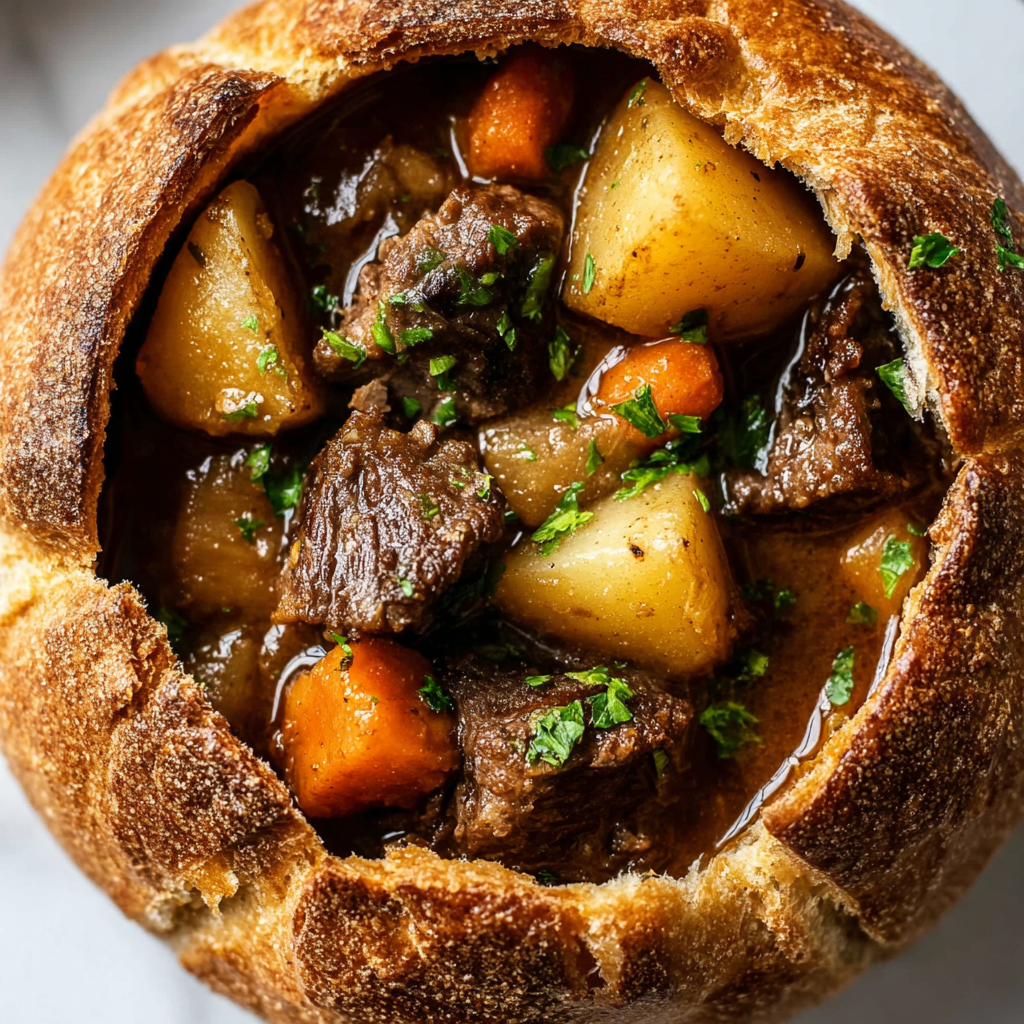There’s something utterly magical about the way a hearty beef stew fills your kitchen with aromatic warmth on a crisp October evening. Five years ago, while planning our first family Halloween dinner party, I wanted to create something that would satisfy both our need for comfort food and our desire for spooky seasonal fun. That’s when this Witch’s Cauldron Beef Stew was born – a recipe that transforms an ordinary weeknight dinner into an enchanting Halloween experience.
The inspiration struck me while watching my grandmother’s old beef stew recipe bubble away in her heavy Dutch oven, which looked remarkably like something you’d find in a witch’s kitchen. By adding dramatic presentation elements and embracing the natural “witchy” appearance of a rich, dark stew, I created a dish that’s become our Halloween tradition.
What makes this recipe truly special isn’t just its theatrical presentation – though serving it in hollowed-out bread bowls does create an absolutely stunning cauldron effect. The real magic lies in how the red wine and slow simmering process create layers of complex flavors that make this stew worthy of any dinner party, Halloween-themed or otherwise.
Why This Bewitching Stew Will Cast a Spell on Your Dinner Table
Show-Stopping Presentation: The combination of rich, dark stew served in rustic bread bowls creates an authentically medieval appearance that perfectly captures Halloween’s mysterious atmosphere. Furthermore, the steam rising from each “cauldron” adds dramatic flair that delights both children and adults.
Ultimate Comfort Food Appeal: This isn’t just a themed gimmick – it’s a genuinely satisfying, restaurant-quality stew that happens to look spectacular. Meanwhile, the long simmering process creates fork-tender beef and perfectly melded flavors that epitomize autumn comfort cooking.
Perfect Party Planning Solution: Unlike fussy Halloween dishes that require last-minute assembly, this stew actually improves with time and can easily feed a crowd. Additionally, the one-pot cooking method means less cleanup when you’re hosting a houseful of costumed guests.
Seasonal Ingredient Celebration: The recipe showcases autumn’s best flavors with hearty root vegetables and rich red wine, creating a dish that tastes like the essence of fall captured in a bowl.
Essential Ingredients and Serving Information
Serves: 4 hungry Halloween revelers
Prep Time: 20 minutes
Cook Time: 2 hours
Total Time: 2 hours 20 minutes
Difficulty: Intermediate (perfect for confident home cooks)
Core Stew Components
- 1 lb beef stew meat (chuck roast cut into chunks works beautifully)
- 2 cups beef broth (high-quality broth makes a noticeable difference)
- 1 cup red wine (use something you’d actually drink)
- 3 carrots, sliced (cut into substantial pieces for hearty texture)
- 2 potatoes, cubed (Yukon Gold or russet both work well)
- 1 onion, chopped (yellow onions provide the best flavor base)
- 2 cloves garlic, minced (fresh garlic is essential for depth)
Flavor Enhancement Elements
- 2 tbsp tomato paste (adds richness and umami depth)
- 1 tsp dried thyme (classic herb pairing with beef)
- 1 bay leaf (removes before serving for subtle aromatic notes)
- Salt and pepper to taste (season generously for best results)
Theatrical Presentation Option
- Hollowed-out bread bowls (sourdough or round crusty loaves work best)
- Fresh herbs for garnish (thyme sprigs or parsley add color)
- Extra bread for dipping (don’t let those bread bowl centers go to waste)

Step-by-Step Magical Cooking Process
Building the Flavor Foundation
Step 1: Begin by patting your beef stew meat completely dry with paper towels – this crucial step ensures proper browning rather than steaming. Then, heat a large, heavy-bottomed pot or Dutch oven over medium-high heat until it’s thoroughly warmed.
Step 2: Add the beef pieces in a single layer, avoiding overcrowding which would prevent proper browning. Allow each side to develop a rich, golden-brown crust before turning, approximately 3-4 minutes per side. This browning creates the foundation of flavor for your entire stew.
Creating the Aromatic Base
Step 3: Once the beef is beautifully browned on all sides, add the chopped onion to the same pot, utilizing those flavorful browned bits stuck to the bottom. Sauté the onion until it becomes translucent and slightly caramelized, approximately 5 minutes.
Step 4: Add the minced garlic and continue cooking for another minute until fragrant. Then, stir in the tomato paste, dried thyme, and bay leaf, allowing these ingredients to bloom and release their essential oils for about 30 seconds.
The Wine Deglazing Magic
Step 5: Pour in the red wine while the pot is still hot, immediately scraping up all those precious browned bits from the bottom using a wooden spoon. This deglazing process captures every bit of developed flavor and prevents burning while creating a rich base for your stew.
Step 6: Allow the wine to simmer vigorously for 2-3 minutes, reducing slightly and cooking off the raw alcohol taste while concentrating the flavors.
Building the Complete Stew
Step 7: Add the beef broth, sliced carrots, and cubed potatoes to the pot, stirring everything together until well combined. The liquid should just cover the solid ingredients – add a bit more broth if needed.
Step 8: Bring the entire mixture to a rolling boil, then immediately reduce the heat to low and cover the pot. Allow the stew to simmer gently for 1.5 to 2 hours, stirring occasionally to prevent sticking and checking that the liquid level remains adequate.
Final Seasoning and Presentation
Step 9: After the beef becomes fork-tender and the vegetables are cooked through, remove the bay leaf and taste the stew carefully. Season generously with salt and pepper, adjusting until the flavors are perfectly balanced.
Step 10: If serving in bread bowls, hollow out your crusty loaves carefully, leaving sturdy walls that won’t leak. Ladle the piping hot stew into each “cauldron” and serve immediately while steam is still rising dramatically.
Spellbinding Serving and Presentation Ideas
Authentic Witch’s Kitchen Setup: Dim the dining room lights and serve by candlelight, placing each bread bowl cauldron on dark plates surrounded by autumn leaves and small pumpkins. This atmospheric presentation transforms dinner into a true Halloween experience.
Family-Style Cauldron Centerpiece: Serve the stew in a large black cast-iron pot placed directly on the table as a centerpiece, allowing guests to ladle their own portions into individual bread bowls for interactive dining.
Elegant Halloween Dinner Party: Present in traditional bowls garnished with fresh thyme sprigs and accompanied by the hollowed-out bread pieces toasted with garlic butter as sophisticated dipping bread.
Kid-Friendly Spook Factor: Create “potion labels” for each bread bowl cauldron, describing the magical properties of your “witch’s brew” to delight young Halloween enthusiasts while they enjoy their nutritious dinner.
Enchanting Recipe Variations to Explore
Hearty Mushroom Witch’s Brew
Add 8 oz of sliced mushrooms along with the onions for earthy, umami-rich depth. Furthermore, substitute half the beef broth with mushroom broth for an intensely savory flavor profile that mushroom lovers will adore.
Root Vegetable Harvest Version
Include parsnips, turnips, and sweet potatoes along with the traditional carrots and potatoes. This variation celebrates autumn’s bounty while creating a more complex vegetable medley that adds natural sweetness.
Spicy Cauldron Concoction
Add 1-2 chipotle peppers in adobo sauce and a pinch of cayenne pepper for smoky heat that warms you from within. Additionally, garnish with fresh jalapeño slices for guests who enjoy extra spice.
Guinness Witch’s Stew
Replace the red wine with dark stout beer for a rich, malty flavor that pairs beautifully with beef. This Irish-inspired variation creates an even darker, more mysterious appearance perfect for Halloween ambiance.
Masterful Make-Ahead and Storage Strategies
Advance Preparation Benefits: This stew actually improves in flavor when made 1-2 days ahead, as the extended resting time allows all ingredients to meld together beautifully. Simply reheat gently before serving in your dramatic bread bowl presentations.
Freezing Capabilities: The stew base freezes exceptionally well for up to three months when stored in airtight containers. However, consider adding fresh vegetables when reheating, as previously frozen potatoes and carrots can become mushy.
Slow Cooker Adaptation: Brown the meat and sauté the aromatics as directed, then transfer everything to a slow cooker for 6-8 hours on low heat. This method works wonderfully for busy Halloween party preparation days.
Leftover Transformation: Remaining stew makes an excellent pie filling when thickened slightly with cornstarch, creating a completely different meal from the same magical base.
Professional Cooking Tips for Perfect Results
Meat Selection Strategy: Choose well-marbled chuck roast and cut it into uniform 2-inch pieces for optimal tenderness and even cooking. Pre-packaged “stew meat” often contains various cuts that cook at different rates.
Wine Quality Importance: Use a wine you would actually enjoy drinking – if it’s not good enough for your glass, it’s not good enough for your stew. The wine’s flavor concentrates during cooking, so quality matters significantly.
Bread Bowl Preparation: Create bread bowls shortly before serving to prevent sogginess. Save the scooped-out bread centers for making breadcrumbs or croutons rather than wasting this delicious component.
Thickening Techniques: If you prefer a thicker stew, mix 2 tablespoons of flour with cold water to create a slurry, then stir it into the simmering stew during the last 15 minutes of cooking.

Frequently Asked Questions
Q: Can I make this stew without red wine? A: Absolutely! Replace the wine with an equal amount of additional beef broth plus 1 tablespoon of balsamic vinegar for acidity. The flavor will be different but still delicious, though you’ll lose some of the rich complexity that wine provides.
Q: What’s the best cut of beef for stew meat? A: Chuck roast is ideal because it contains enough fat and connective tissue to become incredibly tender during long, slow cooking. Avoid lean cuts like sirloin, which can become tough and dry in stews.
Q: How do I prevent my bread bowls from getting soggy? A: Hollow out the bread just before serving, and consider brushing the inside with melted butter or olive oil as a moisture barrier. Additionally, serve the stew immediately while it’s hot to minimize soaking time.
Q: Can I use sweet potatoes instead of regular potatoes? A: Yes, but add them during the last 45 minutes of cooking since sweet potatoes cook faster than regular potatoes. They’ll add natural sweetness that complements the red wine beautifully.
Q: How do I know when the beef is tender enough? A: Properly cooked stew meat should fall apart easily when pierced with a fork and offer no resistance when chewed. If it’s still tough after 2 hours, continue simmering and check every 30 minutes.
Q: Can I make this in a pressure cooker or Instant Pot? A: Certainly! Brown the meat using the sauté function, then add all other ingredients and cook on high pressure for 35 minutes with natural release. The flavors won’t develop quite as deeply as with traditional slow simmering, but it’s a great time-saving option.
Q: What sides pair well with this Halloween stew? A: Crusty bread for dipping, a simple green salad to cut the richness, roasted Brussels sprouts for seasonal appeal, or garlic mashed potatoes if you want to make it extra hearty. Keep sides simple to let the stew shine as the star.

